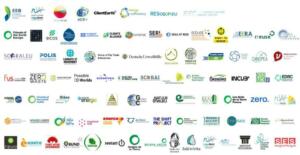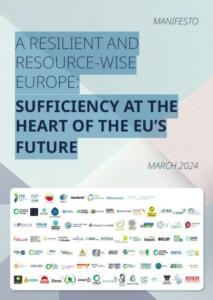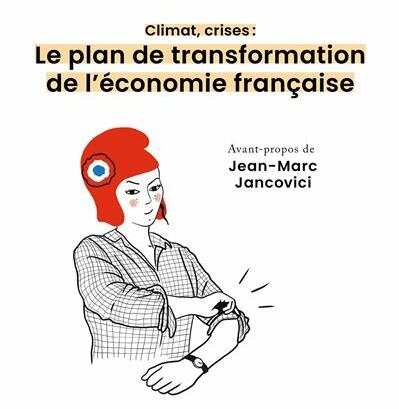The Shift Project is pleased to be associated with this joint call for the integration of sobriety (energy and materials) into the next cycle of European institutions.
Download the manifesto (8p.)
I – Why managing demand through sufficiency policies is needed now
EU leaders are seeking to maintain stability in an evolving era of ‘polycrisis’. The covid 19 pandemic, the Russian invasion of Ukraine, and a volatile geopolitical situation resulting in price increases have all contributed to instability. They have brought questions of security of supply, strategic autonomy, and industrialisation back to the top of the EU agenda. Yet so far, the EU has sought to address this agenda without seriously considering a critical lever at its disposal: managing Europe’s resource use. Faced with surges in cost of living, growing inequality of wealth and income, and unprecedented consequences of climate change, the EU must take advantage of all levers available – including resource-wise demandside policy – to ensure its economy is fit to deliver well-being and protection for all.
The coming European elections and the next EU institutions’ mandate will be a critical time to decide how to shape a path to resilience: by continuing to increase our dependencies and inequalities, or to put demand management at the heart of the EU strategic agenda through a sufficiency-driven approach.
The IPCC describes sufficiency as policies, measures, and daily practices that avoid the demand for energy, materials, water, and land while delivering human well-being for all within planetary boundaries1. Sufficiency provides infrastructure and legal frameworks to tailor demand to fundamental needs, making the most effective use of selected resources. By putting sufficiency at the heart of its policies, the EU can set itself on the path of a resource-wise and resilient global leadership, providing a more secure, fair, and less costly transition to net zero emissions.
| Sufficiency focuses on the needs of people and thus on wellbeing. By prioritising the amount, level, and nature of goods and services that require resources, sufficiency is different from efficiency, which is concerned with reducing the relative amount of resources needed to provide a given good or service by technological solutions. Services and work-places closer to homes, an adequate public transport infrastructure accessible and affordable for all, vehicle sizes adapted to needs, shared building spaces and a more efficient living space distribution that avoids both over- and under-occupation, better- quality clothes, longer-lasting products, more plant-based food and decent access to drinking water for all, all have to do with sufficiency. Such changes require adequate policies. |
When citizens are asked about policy priorities for climate action or even for the EU in general, they call for sufficiency: 40% of all measures recommended by Climate Citizens Assemblies across Europe are sufficiency-related2. French citizens voted for sufficiency as their first recommendation in the convention on the future of the EU3. Cities and regions are adapting their infrastructures and services to reduce their resource consumption, capitalising on the measures introduced to cope with the recent energy price crisis and droughts4. This is aligned with science: the IPCC underlines the gap regarding demand-side options in national plans5 and recommendations from scientists, such as the European Scientific Advisory Board on Climate Change, are increasingly calling for demand-focused pathways which incorporate sufficiency6.
But EU leaders have so far failed to acknowledge the role sufficiency policies can and must play to address the challenges ahead, making sufficiency the key missing lever in EU policy. Scenario modelling may partly explain this, as classical economic models have failed to properly reflect the potential and multiple co-benefits that low-demand scenarios highlight7. While some parts of EU policy do integrate sufficiency aspects, the EU lacks an overall strategy and the reflex to integrate sufficiency cross-sectorally.
“The time has come to adopt sufficiency across Europe. We call for sufficiency to become a central part of the EU’s strategic agenda. The European Commission should propose an EU sufficiency strategy in the first year of the next mandate as part of the renewed focus on security, competitiveness and just transition. The EU sufficiency strategy should identify the sufficiency policy gap and potential overall and across the different sectors, and propose an action plan to deliver this potential through policies and measures in different sectors for 2030, 2040, and 2050. The strategy should aim at integrating sufficiency :
• in a future 2040 climate, energy, and materials framework including binding reduction targets for energy and material consumption, and a revised and extended governance regulation
• in relevant EU policies and legislation.”
Despite the European Union’s abundant use of and access to energy and resources, we have not yet been able to ensure that all citizens can meet their fundamental needs or access key services, and growing inequalities are threatening to rip apart the social fabric of our democracies. The EU elections offer European political leaders the opportunity to better serve their citizens, and empower them while making society and the economy more resilient. Sufficiency must be at the heart of that agenda.
II – Five reasons to make sufficiency a priority for the EU
1. Sufficiency means a more resilient Europe
Sufficiency can make the EU and its citizens more resilient by guaranteeing the delivery of crucial goods and services while optimising the supporting infrastructure8, e.g. by tackling wasteful electricity demand to plan an optimised and cost-efficient grid infrastructure.
It can make Europe less dependent on imports of energy and other resources9: reaching almost full energy independence by 2050 based on domestic renewable energy resources is possible under a scenario incorporating sufficiency throughout consumption sectors10. Another scenario reaches climate neutrality by 2040 by phasing out all fossil fuels and nuclear, a shift to 100% renewable energy as well as ambitious energy demand reduction across different sectors (i.e. industry, buildings, transport) including sufficiency policies11. This limits the need for high-risk technologies with uncertain availability and costs and reduces pressure on materials (i.e. mining for critical minerals) in third countries and Europe. Overall, scenarios with high sufficiency assumptions reduce both socio-economical, sanitary and environmental impacts and technological and natural risks compared to scenarios relying more on technological options12. In particular, sufficiency can help safeguard Europe’s water resources, at a time when this essential common good, vital both for humans and numerous industrial processes, is becoming increasingly scarce and conflicts over its various uses are emerging. Implementing long-term, collaborative planning for water management integrating sufficiency can further help prevent potential conflicts between regions and countries, thereby further enhancing Europe’s security.
By reducing demand and using resources wisely domestically, Europe can be less dependent on critical imports, less vulnerable to shortages, and more resilient to shocks. Sufficiency can thus provide the EU with more freedom of choice in trading partners and goods as well as greater resilience to global risks.
2. Sufficiency means less costs and more competitiveness
At a time when energy transition and reindustrialisation call for profound transformations, sufficiency minimises costs as it avoids wasting resources, as well as unnecessary infrastructure investments. In several modelling exercises with multiple scenarios, those with the most ambitious sufficiency assumptions had the lowest total energy system costs. This includes the European Commission’s 2040 scenarios where the “LIFE” scenario reduces costs by 3,6% and investments by 8%13. Household and business’ water and energy bills can also be cut, by mitigating price increases due to investments in supply infrastructure and by reducing the amount of energy or water consumed and therefore billed. Finally, it enables businesses to shift to models that create value by sharing and preserving resources e.g. through customer relations based on local value, community, quality, and confidence.
Sufficiency also has positive macroeconomic benefits compared to business as usual14. By cutting further and faster the need for imports, sufficiency would allow the EU to save around €200 billion per year – savings which could be reinvested domestically15. Sufficiency can help achieve a successful, prioritised reindustrialisation, by focusing on sectors that are strategic, reducing costs and minimising risks, thus strengthening the EU’s competitiveness16 17 18. This needs to be done with social dialogue and collective bargaining at the core to ensure the creation of decent jobs.
3. Sufficiency means facilitated achievement of our climate and energy targets
Sufficiency can enable Member States to deliver on EU objectives most cost-effectively and increase the likelihood of meeting decarbonisation targets19 20. It has the potential to reduce Europe’s final energy demand by 20-30% by 2050, depending on the country and sector21. This means achieving the same level of decarbonisation with lower European Emissions Trading System allowance price levels which would lessen the burden on citizens and businesses. The IPCC also states that greenhouse gas emissions can be reduced by 40-70% through demand-side strategies (including efficiency)22 and about 29% through sufficiency23. Sufficiency can contribute to reducing EU and global energy consumption, facilitating the progress of renewables in the global energy mix and fossil fuels phase-out24. By addressing over-consumption and rebound effects, sufficiency can release the full potential of technological progress in efficiency and renewable energies and act as a key complement to efficiency and renewable energy policies25. For example, by optimising the expansion of electric renewables (including by better targeting the use of hydrogen and its derivatives for priority applications), sufficiency policies reduce the need for electricity infrastructure development and materials, therefore contributing to increased local acceptance of the transition and likelihood of success26.
4. Sufficiency means a better quality of life for all
Sufficiency can increase equity both within Europe and globally27. By targeting the most unsustainable consumption patterns in particular, sufficiency restores demand to levels that respect planetary boundaries while ensuring that all in society can meet their fundamental needs. It implies a convergence of consumption between the most and least wealthy countries as well as citizens in the EU, thus increasing the fairness of access to resources and services28.
Through less resource extraction, sufficiency also has the potential to slow down value chains. This should be accompanied by retraining schemes for workers within the EU and abroad as workers should benefit from economic transformation and not bear the cost of it. It can create greater space to ensure respect for human and labour rights so that no worker is left behind. Prioritising societal needs and sharing practices at the local and community level can improve various aspects of subjective well-being, including a greater sense of community, life satisfaction, and purpose.
5. Sufficiency means a more sustainable Europe
The EU’s Green Deal is an unprecedented commitment towards climate neutrality and global leadership on the matter. With a strong focus on climate aspects and particularly greenhouse gas emissions, other sustainability issues such as resource depletion and biodiversity decline were not addressed with the same urgency or ambition. Sufficiency has the potential to rebalance EU policy in the next mandate towards strong sustainability.
III – Recommendations: putting sufficiency at the heart of the EU strategic agenda
Sufficiency needs to be at the heart of the next EU mandate and integrated into the EU’s strategic agenda. In the first year of the new mandate, the European Commission should present an EU strategy for sufficiency, based on a thorough analysis of the EU’s sufficiency potential and identification of the current legislative gap across sectors, and propose an action plan aiming to ease the achievement of the 2030 targets and set Europe on the right path to 2040 and 2050. The strategy should:
- be based on revised scenario modelling allowing for a thorough and profound integration and evaluation of sufficiency assumptions;
- incentivise and integrate sufficiency measures within the implementation of the EU 2030 framework and the Fit for 55 packages, including by highlighting existing initiatives at the local and national levels that could be replicated or expanded and assess where the EU, Member States, and local governments are best suited for action;
- make concrete proposals to integrate sufficiency within the EU 2040 framework and relevant EU policies and legislation, as illustrated in the next paragraphs.
Sufficiency at the heart of a 2040 climate, energy and materials framework
Sufficiency must be at the heart of a 2040 climate and energy framework extended to materials that would include, beyond the 2040 climate target:
- A binding EU 2040 energy consumption reduction target for both primary and final energy, complemented with national binding targets.
- A binding material footprint29 reduction target30.
- A revised governance regulation extended to materials including:
–> a sufficiency chapter starting with a definition of sufficiency;
–> a dedicated section for sufficiency measures in the National Energy Climate (and Materials) Plans reporting template, including a quantification in terms of savings;
–> proposals to foster equity through the convergence of per capita consumptions between Member States towards 2050 in meeting relevant targets;
–> the creation of a permanent EU citizen assembly and guidelines for the establishment of permanent assemblies at the national and local level, with a view to co-developing, operationalising, and monitoring (sufficiency) policies.
Sufficiency at the heart of EU (sectoral) policies
Sufficiency can promote well-being and improve security and resilience across all energy-, material- and resource-intensive sectors. This means sufficiency can – and must – be integrated across relevant sectoral policy and legislation.
Sufficiency policies can take many forms and must be based on an appropriate assessment of social, distributional and environmental impacts to ensure they generate the full potential of positive impacts across the board. By way of example, pursuing sufficiency on a sectoral basis could include:
Transport / mobility
a. Setting frameworks and incentives – including a massive shift in infrastructure investments – to support the reduction of individual car use by making public transportation, car-pooling, and sharing as well as cycling and walking more attractive and available, and by promoting short-distance travel and a more localised provision of services and supplies.
b. Recognizing there will still be significant car use in decades to come, addressing excessive and unnecessary characteristics of cars through criteria that better address the weight, dimensions, and environmental footprint of vehicles.
c. Eliminating unnecessary air traffic through, for example, progressively prohibiting air travel options where there is a train alternative and introducing a frequent flyer levy.
Energy, buildings and spatial planning
a. Prioritising optimising use of existing buildings and spaces over new builds by promoting or updating existing tax regimes, zoning rules, building codes, and other policies which favour recording and repurposing vacant buildings, multiple use and sharing spaces in buildings, and by working toward a 2050 net zero land-take target as well as a stabilisation of average dwellings size per capita in the EU.
b. Aiming for a performance-based policy framework for measuring and reducing the whole-life carbon footprint of buildings in order to act upon all the available carbon reduction opportunities in the building stock.
c. Implementing circularity principles that allow for the same functional results for building users but with lower material use.
d. Incorporating resilience planning into building codes and regulations, requiring new constructions and renovations to consider adaptability and flexibility in design to address future challenges such as climate change impacts.
e. Incorporating sufficiency and prioritising low-demand pathways and options as a guiding principle in urban, infrastructure, and spatial planning frameworks, including through EU funds and programmes.
f. Introducing progressive tariff frameworks favouring lower energy and water consumption, complementing deep retrofit policies and financial schemes particularly targeting low income consumers.
Materials, products, food and water
a. Adopting and implementing a new EU Directive on Sustainable Resource Management, which would set a binding EU material footprint reduction target in line with the best available research on sustainable consumption levels, and steer the EU and its Member States to develop sufficiency strategies for the achievement of that target, including through the extended governance regulation.
b. Promoting resource and material sufficiency through product design rules aimed at limiting absolute energy and resource consumption, such as eliminating categories of single-use products, shifting recovery and recycling obligations toward producers and away from consumers, improving durability and repairability, and ending the destruction of unsold products.
c. Advancing a new governance and funding framework for food systems aimed at improving the resilience and sustainability of food production and consumption across the entire value chain, in a manner that is mutually beneficial for farmers and the environment.
d. Increasing food waste prevention through targets and better integrating the polluter pays principle (e.g., PAYT) in waste management frameworks.
e. Increasing water resilience by embedding water-related impact assessment across all EU policies, in particular energy, raw materials and the Common Agricultural Policy.
f. Promoting efficient and sustainable use of water resources based on participatory governance and long-term planning, in line with the requirements of the Water Framework Directive, as a condition to reduce the risk of conflicts between users and territories.
Cross-sectoral: taxation and finance
a. Mapping taxation practices at local and national levels that encourage sufficiency, including an analysis of their social and distributional impacts, with a view to exploring EU wide approaches for tax reform and adopting a recommendation on the topic.
b. Leveraging EU funding schemes for local, citizen-driven, and bottom-up sufficiency projects, for example by using the EU’s Recovery and Resilience, Cohesion and Modernisation funds31, the Social Climate Fund or providing specific technical assistance through the TSI of DG GROW to help municipalities, citizens and energy communities in carrying out projects that decrease absolute energy and resource consumption.
Endnotes
1 – Intergovernmental Panel on Climate Change, Climate Change 2022: Mitigation of Climate Change – Working Group III Contribution to the Sixth Assessment Report, 2022
2 – Lage et al, Citizens call for sufficiency and regulation — A comparison of European citizen assemblies and National Energy and Climate Plans, 2023
3 – Contribution citoyenne à la Conférence sur l’avenir de l’Europe, 2021 Normal (vie-publique.fr)
4 – Energy Cities, Sufficiency, the missing pillar for a resource-wise Europe, December 2023
5 – Intergovernmental Panel on Climate Change, Climate Change 2022: Mitigation of Climate Change – Working Group III Contribution to the Sixth Assessment Report, 2022
6 – European Scientific Advisory Board on Climate Change, Towards EU climate neutrality: progress, policy gaps, and opportunities, Assessment Report 2024, 2024
7 – Olivia Gyapong and Thomas Moller-Nielsen, ‘Something is not working’: Economists urge EU Commission to overhaul its models, 15 February 2024
8 – Nuno Bento et al., Leverage demand-side policies for energy security, Science 383,946-949, 2024
9 – “Pathways with lower energy and natural resource use advance the Sustainable Development Goals and energy security and lower other risks compared to pathways that prioritise supply-side technological solutions”, European Scientific Advisory Board on Climate Change, 2024
10 – CLEVER, Climate neutrality, Energy security and Sustainability: A pathway to bridge the gap through Sufficiency, Efficiency and Renewables, Final report, June 2023
11 – CAN Europe/EEB technical summary of key elements, Building a Paris Agreement Compatible (PAC) energy scenario, June 2020
12 – ADEME, Transitions 2050 (Synthese), March 2024
13 – European Commission 2040 Climate target, Impact Assessment Report Part 1, February 2024
14 – ADEME, Transitions 2050 (Feuilleton) : Les effets macroéconomiques, March 2020
15 – Institut Rousseau, Road to Net Zero, January 2024
16 – Jean Chateau & Eleonora Mavroeidi, OECD Environment Working Papers No. 167, The jobs potential of a transition towards a resource efficient and circular economy, 2020
17 – University of Cambridge Institute for Sustainability Leadership (CISL). (2023). Inclusive Circularity: Creating decent and fair jobs in the EU. Cambridge, UK: CLG Europe
18 – Circle economy & EHERO, Circular Jobs – Understanding Employment in the Circular Economy in the Netherlands, 2017
19 – Cap et al, (In)Sufficiency of industrial decarbonization to reduce household carbon footprints to 1.5°C-compatible levels, Sustainable Production and Consumption, Volume 45, 2024, Pages 216-227
20 – European Scientific Advisory Board on Climate Change, Towards EU climate neutrality: progress, policy gaps, and opportunities, Assessment Report 2024, 2024
21 – CLEVER Final report, June 2023
22 – IPCC, Climate Change 2022 Mitigation of Climate Change Working Group III Contribution to the Sixth Assessment Report, Summary for Policy Makers, 2022
23 – Jean Pisani-Ferry et Selma Mahfouz, Les Incidences économiques de l’action pour le climat, May 2023
24 – EERA, Energy demand reduction as part of the clean energy transition in Europe: Research and policy strategies, 2023
25 – Eg in the appliances and cars sectors, sufficiency measures are necessary complements to successful efficiency regulations, which have often been offset by increasing fleets, sizes, and uses
26 – CLEVER Final report, June 2023
27 – Allowing countries in the Global South to access a fair share of the resources they need for their own transition towards climate neutrality, Global Resource Outlook 2024, International Resource Panel, UNEP, March 2024
28 – CLEVER Final report, June 2023
29 – Raw material consumption, as measured by Eurostat.
30 – Bringezu, 2015, 2019; Dittrich et al., 2012; O’Neill et al., 2018, “White Paper for an EU within Planetary Boundaries, Framework on Sustainable Resource Management in the EU”
31 – Rescoop.EU, Financing tracker
32 – Olivia Gyapong and Thomas Moller-Nielsen, ‘Something is not working’: Economists urge EU Commission to overhaul its models, 15 February 2024
List of signatories: Air pollution & Climate Secretariat – Amigos de la tierra – An Tascie – The national trust for Ireland – Aqua Publica Europea – négaWatt Association – Association of Cities and Regions for sustainable Resource management – BUND – Friends of the Earth Germany – CANOPEA – CELL – the transition hub – CLER – Réseau pour la transition energetique – ClientEarth – Climate Alliance – CoopTech Hub – Danmark Naturfredningsforening – DUH Deutsche Umwelthilfe – Ecoserveis – Ecoteca – eco-union – EERA European Energy Research Alliance – Electra energy.coop – Enercoop – Enerdata – Energy Demand Research Centre – Energy Sufficiency Research Group (EnSu) – Energy Cities – ènostra coop – Environment Engineering group (EEG) – ECOS – Environmental Coalition on Standards – Environmental Planning & Education Network (EPEN), Hungary – European Council for an Energy Efficient Economy – European Environmental Bureau – European Federation of Agencies and Regions for Energy and Environment ( FEDARENE) – ECOLISE – European Network for Community-Led Sustainability Initiatives – European Youth Forum – Feedback EU – FossilExit Research Group – France Nature Environnement – Friends of the Earth Croatia – Friends of the Earth Europe – Friends of the Earth Malta – Fundacion Vida sostenible – Global 2000 (Friends of the Earth Austria) – Global Chance – Greendependent Institute – Green transition Denmark – Greenformation – Grüne Liga e.V. – Home of fair trade enterprises – Humusz waste prevention alliance – Incub’ – Institut Veblen – International Network for Sustainable Energy – Europe – Institut Rousseau – Jacques Delors Energy Institute – Laudato Si’ Movement – Les amis de la terre Belgique – Les amis de la terre France – Magyar Természetvédők Szövetsége – Natuur&Milieu – negaWatt Belgium – negaWatt Schweiz – Oikos – ÖKOBÜRO – Alliance of the Environmental Movement – Polis, Cities and regions for transport innovation – Polskie Stowarzyszenie Zero Waste – Polish Economic Network – Possible worlds – Quercus – Associação Nacional de Conservação da Natureza – Rescoop.EU – Réseau Action Climat – Restart – REVO – Prosperidad Sostenible – Right to repair – RREUSE – Seas At Risk – Sustainable Consumption Research and Action Initiative (SCORAI) – Sustainable Consumption Research and Action Initiative Europe (SCORAI.EU) – Sustainable Europe Research Institute – The Shift Project – Schweizerische Energie-Stiftung SES – Umweltdachverband – Virage Energie – Zala Briviba, Green Liberty – Zero – Zero Waste Europe



